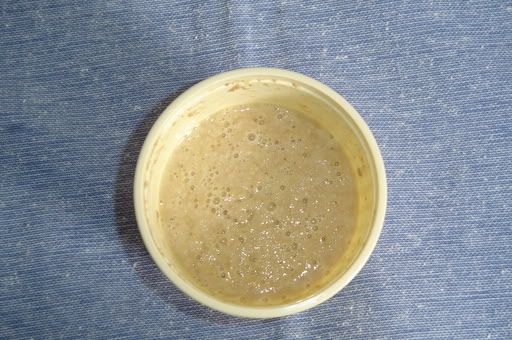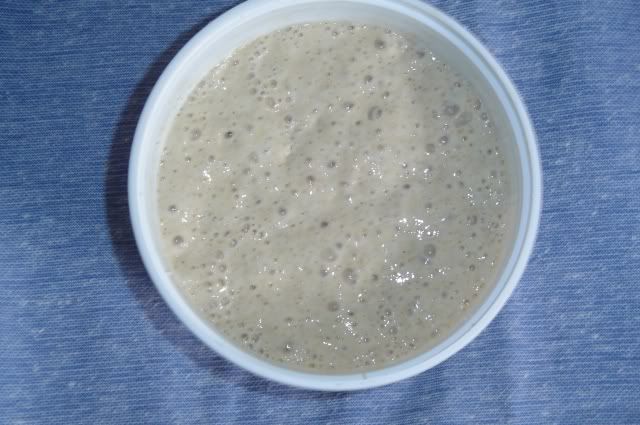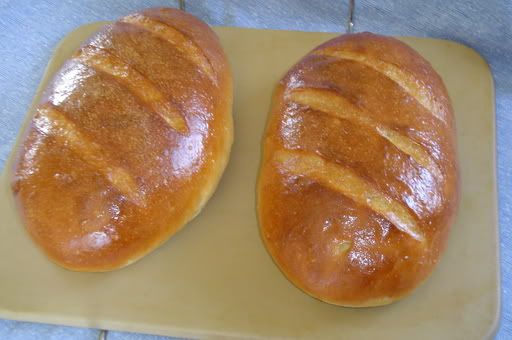
I have been baking with wild yeast sourdough for the past 5 years. It all began when I purchased a starter from Sourdoughs International. One starter led to another starter, until I had 5 different ones. Recently, I felt up to the challenge of making my own wild yeast starter from scratch. I had tried this once before, many years ago, with no success at all. At that time I knew next to nothing about wild yeast and how it works.
This starter recipe is awesome because it really works, and it explains why it works. The starter I made is very good. The flavor is amazing and it rises very well. I purchased rye and wheat berries at my local health food store and ground them in a coffee grinder to make flour for my starter. It was kind of tedious to grind but I only needed a few tablespoons. I'm sure that you could just buy freshly milled flour at the health food store and it would work just as well. The wild yeast is on the grains and you just need to provide the right conditons to wake it up.
Procedure for Making Sourdough Starter
Day 1: mix...
2 T. whole grain flour (rye and/or wheat)
2 T. unsweetened pineapple juice or orange juice
Cover and let sit at room temperature for 24 hours.
Day 2: add...
2 T. whole grain flour
2 T. juice
Stir well, cover and let sit at room temperature 24 hours. At day 2 you may (or may not) start to see some small bubbles.
Day 3: add...
2 T. whole grain flour
2 T. juice
Stir well, cover and let sit at room temperature 24 hours.
Starter at Day 3:

Day 4:
Stir down, measure out 1/4 cup and discard the rest.
To the 1/4 cup add...
1/4 cup flour*
1/4 cup filtered or spring water
*You can feed the starter whatever type of flour you want at this point (unbleached white, whole wheat, rye). If you are new to sourdough, a white starter is probably the best choice. All-purpose flour is fine--a high protein flour is not necessary.
Repeat Day 4:
Once daily until the mixture starts to expand and smell yeasty. It is not unusual for the mixture to get very bubbly around Day 3 or 4 and then go completely flat and appear dead. If the mixture does not start to grow again by Day 6, add 1/4 tsp. apple cider vinegar with the daily feeding. This will lower the pH level a bit more and it should wake up the yeast.
Starter at Day 7:

How it Works
The yeast we are trying to cultivate will only become active when the environment is right. When you mix flour and water together, you end up with a mixture that is close to neutral in pH, and our yeasties need it a bit more on the acid side. This is why we are using the acidic fruit juice. There are other microbes in the flour that prefer a more neutral pH, and so they are the first to wake up and grow. Some will produce acids as by-products. That helps to lower the pH to the point that they can no longer grow, until the environment is just right for wild yeast to activate. The length of time it takes for this to happen varies.
When using just flour and water, many will grow a gas-producing bacteria that slows down the process. It can raise the starter to three times its volume in a relatively short time. Don't worry--it is harmless. It is a bacteria sometimes used in other food fermentations like cheeses, and it is in the environment, including wheat fields and flours. It does not grow at a low pH, and the fruit juices keep the pH low enough to by-pass it. Things will still progress, but this is the point at which people get frustrated and quit, because the gassy bacteria stop growing. It will appear that the "yeast" died on you, when in fact, you haven't begun to grow yeast yet. When the pH drops below 3.5--4 or so, the yeast will activate, begin to grow, and the starter will expand again. You just need to keep it fed and cared for until then.
Once your wild yeast is growing, the character and flavor will improve if you continue to give it daily feedings and keep it at room temperature for a couple of weeks longer.
After that time, it should be kept in the refrigerator between uses/feedings.
My First Loaves From New Starter:

This starter recipe is awesome because it really works, and it explains why it works. The starter I made is very good. The flavor is amazing and it rises very well. I purchased rye and wheat berries at my local health food store and ground them in a coffee grinder to make flour for my starter. It was kind of tedious to grind but I only needed a few tablespoons. I'm sure that you could just buy freshly milled flour at the health food store and it would work just as well. The wild yeast is on the grains and you just need to provide the right conditons to wake it up.
Procedure for Making Sourdough Starter
Day 1: mix...
2 T. whole grain flour (rye and/or wheat)
2 T. unsweetened pineapple juice or orange juice
Cover and let sit at room temperature for 24 hours.
Day 2: add...
2 T. whole grain flour
2 T. juice
Stir well, cover and let sit at room temperature 24 hours. At day 2 you may (or may not) start to see some small bubbles.
Day 3: add...
2 T. whole grain flour
2 T. juice
Stir well, cover and let sit at room temperature 24 hours.
Starter at Day 3:

Day 4:
Stir down, measure out 1/4 cup and discard the rest.
To the 1/4 cup add...
1/4 cup flour*
1/4 cup filtered or spring water
*You can feed the starter whatever type of flour you want at this point (unbleached white, whole wheat, rye). If you are new to sourdough, a white starter is probably the best choice. All-purpose flour is fine--a high protein flour is not necessary.
Repeat Day 4:
Once daily until the mixture starts to expand and smell yeasty. It is not unusual for the mixture to get very bubbly around Day 3 or 4 and then go completely flat and appear dead. If the mixture does not start to grow again by Day 6, add 1/4 tsp. apple cider vinegar with the daily feeding. This will lower the pH level a bit more and it should wake up the yeast.
Starter at Day 7:

How it Works
The yeast we are trying to cultivate will only become active when the environment is right. When you mix flour and water together, you end up with a mixture that is close to neutral in pH, and our yeasties need it a bit more on the acid side. This is why we are using the acidic fruit juice. There are other microbes in the flour that prefer a more neutral pH, and so they are the first to wake up and grow. Some will produce acids as by-products. That helps to lower the pH to the point that they can no longer grow, until the environment is just right for wild yeast to activate. The length of time it takes for this to happen varies.
When using just flour and water, many will grow a gas-producing bacteria that slows down the process. It can raise the starter to three times its volume in a relatively short time. Don't worry--it is harmless. It is a bacteria sometimes used in other food fermentations like cheeses, and it is in the environment, including wheat fields and flours. It does not grow at a low pH, and the fruit juices keep the pH low enough to by-pass it. Things will still progress, but this is the point at which people get frustrated and quit, because the gassy bacteria stop growing. It will appear that the "yeast" died on you, when in fact, you haven't begun to grow yeast yet. When the pH drops below 3.5--4 or so, the yeast will activate, begin to grow, and the starter will expand again. You just need to keep it fed and cared for until then.
Once your wild yeast is growing, the character and flavor will improve if you continue to give it daily feedings and keep it at room temperature for a couple of weeks longer.
After that time, it should be kept in the refrigerator between uses/feedings.
My First Loaves From New Starter:

- SourdoLady's Blog
- Log in or register to post comments
I made an interesting observation on keeping a starter in the fridge.
After a few weeks I noticed that milk for instance went sour, like I knew from my childhood days, instead of smelling bad. Cheese also stayed fresh longer without putting on mold, especially the black variety.
Anyone make the same observation?
I made an interesting observation on keeping a starter in the fridge.
After a few weeks I noticed that milk for instance went sour, like I knew from my childhood days, instead of smelling bad. Cheese also stayed fresh longer without putting on mold, especially the black variety.
Anyone make the same observation?
Hello SourdoLady,
I am a highschooler in 11th grade working on a senior thesis project. I plan to do something related to fermented sourdough. I see you baked bread from the starter. I have started making the starter, but I am stumped at how to make the bread. How much flour did you use to make the dough and what steps did you take?
Thank You,
Daniel
Here I go - my first day - just started, on the way to yeasty smell...I hope.
I've been seeing where some people say they do 100% hydration what does that mean?
I am on day four of the ps, just added apw flour to it! I am so excited to be on my way to a sourdough bread.
Hi there, thanks for posting this. I'm using our starter guide and purchased organic sprouted rye flour.
On day 1 and it is already very bubbly. I'm hoping this will work, my third try at making a starter.
Thanks for the sharing and encouragement! You've done great loaves that I'm sure are tasty. I'd like to try this but it makes me feel bad thinking how much time and efforts could result in nothing, as that's pretty complicated.
Chad Peterson
essay writer
I'm confused about how much orange juice to use when starting a wild yeast sourdough starter. The recipe for the starter shown in the first posting in this thread is:
Day 1: mix...
2 T. whole grain flour (rye and/or wheat)
2 T. unsweetened pineapple juice or orange juice
Cover and let sit at room temperature for 24 hours.
But in the Handbook the recipe is:
Day 1: mix...
2 T. whole grain flour (rye and/or wheat)
1 T. unsweetened pineapple juice or orange juice
Cover and let sit at room temperature for 24 hours.
I presume that 2T of orange juice is the correct amount but I'm not sure. I apologize if this question has been addressed before.
Thanks for your help,
Stuart
I just found that the formula at the beginning of this thread is correct and agrees with the what is provided in Debra Wink's blog: The Pineapple Juice Solution, Part 2 dated Feb. 27, 2009 at 10:07 am.
The Handbook should be corrected to show 2T. juice on days 1, 2, and 3, not 1T.
Thanks,
Stuart
Hi there. I started with ww flour and water. After first feed there was the big growth caused by bacteria. It’s day 7 and there hasn’t been any activity aside for some bubbles. Between now and then I’ve tried feeding 2xper day, ww flour, a bit of gluten free flour. The mixture smells sour. I decided to give it some apple cider vinegar to lower the ph today. (Day7) but I might have added a bit too much vinegar. Should I add some discard starter back in to dilute the acidity?
The mixture smelling sour is not enough. When the starter is developed, it smells yeasty. From what I've learned so far, there are two distinct kind of bacteria from the flour that is involved. The first type of bacteria eats the flour and expels CO2 (thus the big growth) which makes acid when combined with the water. That acid kills the first bacteria but creates the right environment for the 2nd type of bacteria. It's the 2nd type that create the sourness for sourdough bread. Start feeding your starter with Organic whole grain flour to avoid unwanted impurities. The flour should at least be unbleached. Residue chlorine in bleached flour kills your yeast. If your started is in a jar, wrap a rubber band around it and position it on top of the fed starter. This will help you see the stages: 1) the doubling of volume 2) shrinking but still settled down lower but still above the rubber band. If your starter has developed at this stage, you can smell the difference.
Don't add vinegar. It changes the taste of the resulting bread. To maintain the acidity (lower pH) after all that discarding and adding water, I'd include 25% juice in the water I add after every 4 feedings. It has worked for me. I also always use juice with flour when starting starter from scratch. Include 2 Tbs juice in your water for the next feeding should help.
Adding some discarding starter back has worked for me with a developed starter. I only did it to speed up building to the amount of starter I need. However, if that came out of the fridge, you'd need to feed it for 2-3 days before use.
Thanks Sourdolady for your instructive recipes. This is the second of your Basic Sourdough Loaf recipes I have used mostly successfully, and learning along the way. This particular recipe has been very forgiving of my mistakes from lapse in attention, substitution of ingredients when I ran out of an ingredient etc., or just tweaking it in hope of a lighter loaf. The crumb in my two loaves has consistently been on the small side, although the loaves stays soft and moist until my wife and I finish them. Generally happy, but I do have some questions I like to ask:
Hope to hear your response soon, In the mean time, I will remember to do that window pane test after the kneading next time. I generally knead until my arms are tired and the dough is smooth enough on its surface. Not silky as you prescribe, probably because I use Whole Wheat flour instead of White Whole Wheat as I've not been able to find it in this Covid world!